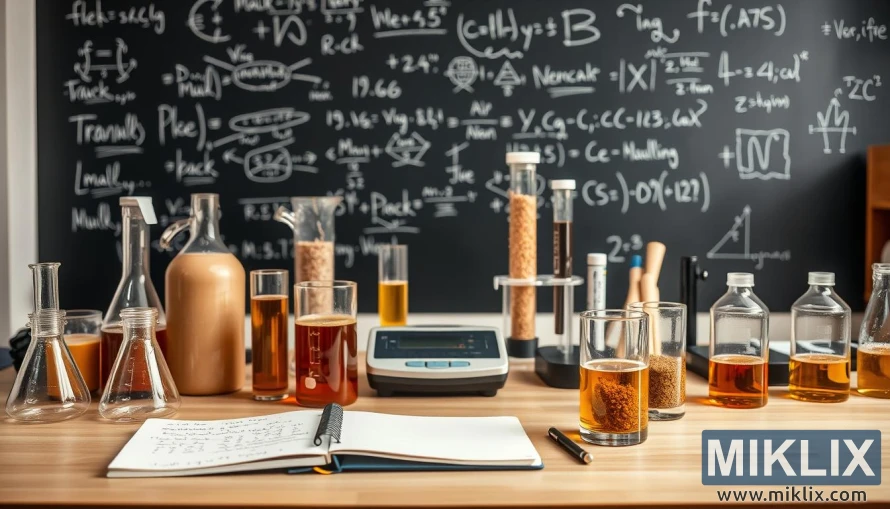Image: Amber Malt Recipe Development Lab
Published: August 6, 2025 at 5:01:05 PM UTC
Last updated: September 27, 2025 at 4:25:33 PM UTC
Organized lab bench with beakers, malt samples, scale, and notes, set against a chalkboard of formulas, highlighting amber malt recipe research.
In a space where science meets the sensory art of brewing, the image captures a laboratory workbench transformed into a stage for amber malt recipe development. The composition is both methodical and evocative, presenting a scene that balances precision with creativity. The wooden surface of the bench is neatly arranged with an array of scientific glassware—beakers, flasks, graduated cylinders, and test tubes—each containing liquids of varying hues, from pale gold to deep amber. These liquids shimmer under the soft, warm lighting that bathes the workspace, suggesting different stages of malt infusion, extraction, or fermentation. The clarity and color of each sample hint at the nuanced flavor profiles being explored, from light caramel notes to richer, toasted undertones.
In the foreground, the glass containers are arranged with deliberate care, their contents reflecting the meticulous nature of the work. Some hold steeped malt solutions, others contain raw or roasted grains suspended in liquid, and a few display stratified layers, indicating sedimentation or chemical separation. The lighting enhances the visual texture of the liquids, casting gentle highlights and shadows that add depth and warmth to the scene. The glassware itself is clean and precise, reinforcing the sense of a controlled, analytical environment where every variable is measured and every result recorded.
Moving into the middle ground, a digital scale sits prominently at the center of the table, its sleek design contrasting with the rustic wood beneath. It is surrounded by small dishes of malt grains, each labeled and portioned for testing. Beside the scale lies an open notebook, its pages filled with handwritten notes, equations, and observations. The handwriting is dense and purposeful, suggesting a researcher deeply engaged in the process—tracking temperature changes, measuring pH levels, and recording sensory impressions. A pen rests nearby, poised for the next insight. This part of the scene conveys the intellectual rigor behind recipe development, where brewing is treated not just as a craft but as a scientific pursuit.
The background is dominated by a large chalkboard wall, its surface covered in a tapestry of white chalk markings. Mathematical equations, chemical formulas, and brewing diagrams crisscross the board in a dynamic, almost chaotic pattern. Familiar expressions like E = mc², ∫f(x)dx, and PV = nRT mingle with brewing-specific notes, creating a multidisciplinary atmosphere that bridges chemistry, physics, and culinary science. The chalkboard is not just decoration—it’s a living document of thought, a visual representation of the brewer’s mind at work. It adds a sense of depth and context to the image, reminding the viewer that every pint of beer begins with inquiry, experimentation, and a willingness to explore.
The overall mood of the image is one of quiet intensity and focused creativity. It evokes the feeling of a late afternoon in the lab, where the light is golden, the air is filled with the scent of malt and steam, and the only sounds are the clink of glass and the scratch of pen on paper. It’s a space where tradition meets innovation, where the humble malt grain is elevated through study and care into something extraordinary. The scene invites the viewer to appreciate the complexity behind amber malt—the way its flavor is shaped by roast level, enzymatic activity, and chemical composition—and to recognize the dedication required to perfect it.
This is not just a laboratory—it’s a sanctuary for brewing science, a place where the pursuit of flavor is grounded in data, and where every experiment brings the brewer one step closer to crafting the perfect amber-hued beer.
The image is related to: Brewing Beer with Amber Malt

